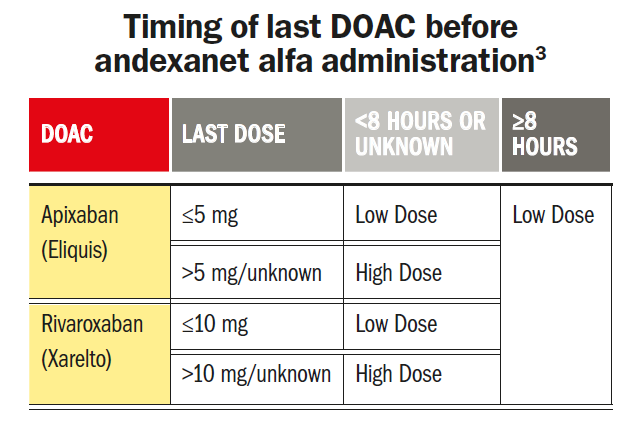Andexxa for Reversal of Factor Xa Inhibitors
Timing of last DOAC before andexanet alfa administration

Overview
Direct oral anticoagulants (DOACs) have revolutionized the drug market. They allow for less frequent INR sticks, consistent dosing regimens, and food choice flexibility. DOAC bleeding risk occurs at an annual rate of 2.1% to 3.5% and increases during surgical interventions.1
Andexanet alfa (Andexxa, Portola Pharmaceuticals) was approved by the FDA in May for emergency reversal of two direct factor Xa inhibitors, rivaroxaban and apixaban.2 The recombinant coagulation factor Xa protein sequesters their anticoagulation effect. Reversal of edoxaban and the indirect inhibitor enoxaparin is also feasible with andexanet,1 but further data on safety and efficacy is needed.
Efficacy
Andexanet is effective in decreasing the activity of rivaroxaban and apixaban within 2 to 5 minutes of administration. It competitively inhibits the factor Xa active site, blocking obtainable receptors for anticoagulation. It also binds directly and seizes apixaban and rivaroxaban in the vasculature.1
In a two-part randomized controlled trial, anti-factor Xa was decreased 94% and 92% for apixaban- and rivaroxaban-treated patients, respectively, compared to 21% and 11% in the placebo arm. Thrombin generation was more than 95% restored in both populations compared to less than 11% (rivaroxaban) and 7% (apixaban) during placebo restoration.1 In the Andexxa-4 trial, 79% of patients were considered at hemostasis and 18% experienced thrombotic events 12 hours postinfusion. Reinitiating anticoagulation therapy following homeostasis is essential, especially in high thrombotic-risk patients.3
Safety
Evidence of clinical toxic effects is minimal; however, the safety of administering more than one dose has not been evaluated.4 Andexanet alfa is associated with thromboembolic events, ischemic events, cardiac arrest, and sudden death.2 Therefore, its use should be restricted for emergency situations due to life-threatening or uncontrolled bleeding.4 Less severe adverse effects include urinary tract infections, pneumonia, and infusion-related reactions.2
Dosing
Andexanet alfa must be administered intravenously. Dissolution for each vial is approximately 3 to 5 minutes and requires coordination between providers, pharmacists, and nursing staff.4
The effects of andexanet alfa are sustained when dosed as a bolus following an IV infusion.1 Bolus doses are targeted at 30 mg/min followed 2 minutes later by an infusion.4 Effective dosing regimens include: Low dose: 400 mg IV bolus followed by 4 mg/minute IV infusion for up to 120 minutes.2 Low dose requires 4 vials bolus plus 5 vials for infusion.
High dose: 800 mg IV bolus followed by 8 mg/minute IV infusion for up to 120 minutes.2 High dose requires 8 vials bolus plus 10 vials for infusion.4 See the Table for more information.
References
1. Siegal DM, et al. Andexanet alfa for reversal of factor Xa inhibitor activity. N Engl J Med 2015; 373:2413-24.
2. Andexanet alfa. Lexi-Drugs. Lexicomp. Wolters Kluwer Health, Inc. Riverwoods, IL. Available at http://online.lexi.com/lco/action/doc/retrieve/docid/patch_f/6640361. Accessed September 30, 2018.
3. Connolly SJ, et al. Andexanet alfa for acute major bleeding associated with factor Xa inhibitors. N Engl J Med 2016; 375:1131-1141.
4. Andexanet alfa (Andexxa) package insert. South San Francisco, CA: Portola Pharmaceuticals, Inc.; 2018.
